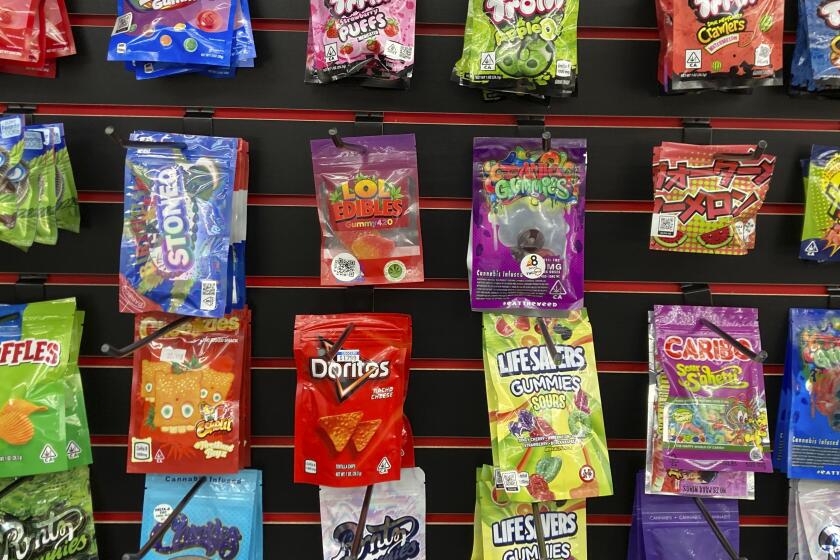Those California warning signs about cancer, birth defects or other reproductive harm are now naming names
A warning sign known to the state of California to cause anything from angst to “meh” has just become bolder and more specific.
As of Friday, consumers have to be told which of the 900 or so compounds “known to the state of California” to cause cancer, birth defects or other reproductive harm is in what they buy, touch, breathe or drink in the course of their day.
The familiar and uniquely Californian signs, which hitherto had hinted ominously at “a chemical,” also will include a yellow triangular hazard symbol with an exclamation point, among other requirements that re-define what constitutes a “clear and reasonable” WARNING (written that way) under the Safe Drinking Water and Toxic Enforcement Act, known as Proposition 65.
Companies are panicking, despite having a two-year grace period to comply. Coming on the heels of a dust-up over state-required warnings on coffee, the latest change has turned renewed attention to California’s unique citizen enforcer law, which allows anyone to test products, put companies on notice and eventually sue for failure to warn about exposures to hazardous substances.
The state office that oversees Proposition 65 has received at least 100 emails and “several hundred” phone calls daily for the last two weeks from companies worried about the new rule — despite (some will argue because of) round after round of public hearings, comments, responses and revisions.
“We don’t know how many prepared in an orderly fashion over the last two years, but it’s fair to say that there are many who have waited until the final days and weeks,” said Sam Delson, a spokesman for the California Office of Environmental Health Hazard Assessment, which oversees the ballot proposition passed by voters in 1986.
“We’ve been waving our arms and saying, here it comes, here it comes, and just like you and me they wait until the last minute,” said Lynn Mohrfeld, president and CEO of the California Hotel & Lodging Assn., representing an industry that has weathered dozens of prosecutions from citizen enforcers of the proposition. “We had a webinar and we had hundreds of people on the call.”
Scientists and public policy experts have questioned whether consumers pay attention to the current warnings, and if they do, whether they are getting enough information to make wise decisions. The newest signs now will include a web link where consumers can investigate the chemical.
David Roe, the environmental attorney who wrote Proposition 65, said the new language should spur manufacturers to reformulate products to eliminate chemicals that can cause harm to consumers. Long before Starbucks faced scrutiny over acrylamide, which is formed from coffee roasting, major national snack companies found ways to keep the substance out of potato chips, he noted.
Although the chip case was handled in a highly public way by the state attorney general, most reformulations go on outside the public view between private enforcers and companies, said Roe. (No company proudly heralds taking a cancer-causing chemical out of its product, he reasoned.)
“The more precise the warning, the more meaningful the warning, the more direct the warning, the fewer there will be,” Roe said. “The right number of Proposition 65 warnings is zero.”
Compliance is crucial to hotels, restaurants and real estate companies, which have paid out several million dollars to ordinary citizens, environmental groups and their attorneys who accused them of failing to warn about the tobacco smoke, automotive fumes, pool chemicals, cleaning supplies, lawn pesticides, grilled meats and a plethora of other substances wafting through commercial buildings.
“Anything without a sign, we get beat up on,” Mohrfeld said.
While the state claims 75% of civil penalties — the plaintiffs get the rest — most settlements are heavily skewed toward attorney fees and other settlement sums to plaintiffs.
Last year, attorney fees accounted for more than $19 million of the nearly $26 million paid out in Proposition 65 cases, according to the state attorney general’s office. The state collected $4.8 million, while plaintiffs collected $1.4 million in “additional settlement penalties,” the attorney general’s office reported.
Nearly 1,000 settlements in 2015 and 2016 resulted in a warning notice — nearly as many as were required in the previous four-year period, according to a Los Angeles Times analysis of attorney general data.
The hotel industry can safeguard itself from additional enforcement by posting the new warnings at check-in desks or including them in reservations and check-in material, instead of in more obscure locations, such as a corner of a front window, Mohrfeld said.
Single properties and state chains find the new requirement easy to meet, Mohrfeld said, but multinational chains are still figuring out how to isolate the warnings to California clients. “Their IT guys are going, wow: I have to segment my worldwide reservation system and do California reservations, specifically?” Mohrfeld said.
Food companies and grocery chains, which have paid out at least $20 million in Proposition 65 settlements over the past three decades, worry that older products with out-of-date warnings will invite “nuisance” lawsuits. They will have to name the chemicals, but won’t need the triangular warning — nor will alcoholic beverages, drugs and some federally regulated workplaces, according to Delson.
Most food-related cases are resolved through reformulations. But some companies, including dietary supplement makers, have opted for posted warnings instead.
Food manufacturers have gradually updated their warnings as they revise labels. Like their hospitality counterparts, however, many may have waited too long, said John Hewitt, policy director for state affairs for the Grocery Manufacturers Assn.
“I think, as with any deadline, you get to the end and you find yourself in a situation where there still might be some sell-through product on the shelves that may or may not be totally compliant,” Hewitt said.
Whether the new signs will help consumers make better-informed decisions is hotly debated by economists and public health officials.
A 2016 study by Harvard and Vanderbilt universities, for example, found that consumers can’t translate warnings about exposure into realistic assessments of risk. They don’t know if they’re being warned of wolves or puppies, in other words.
Proposition 65 warnings, they wrote, “are so prevalent in California that they are likely ignored by many. And consumers may mistakenly assume that items without warnings are safe even though many risky products are exempted, such as foods containing natural carcinogens.”
As Starbucks learned, a “naturally occurring” defense didn’t shelter them from having to warn about a chemical formed by roasting. A state judge ruled in March that the chain had to post Proposition 65 warnings about acrylamide in coffee. The state since stepped in and proposed giving coffee a bye, based on studies that show it has more healthful than noxious characteristics.
The U.S. Food and Drug Administration this week urged California to follow through on harboring coffee from Proposition 65 warnings, saying a cancer warning would be “false or misleading.”
By most scientific estimates, the amount of acrylamide in coffee is less hazardous than the many chemicals in cigarette smoke and automotive fumes.
But consumers may find it harder to assess relative risks posed by acrylamide in a cup of coffee versus BPA in the polymer nosepiece of sunglasses, or phthalates in the plastic cover of a Bible or in bondage tape — each of which have been the subjects of Proposition 65 prosecutions.
Stamping all those products with nearly identical generic warnings, as was the custom before Friday, “leads highly cautious consumers to lump low-risk products in with mass-marketed products that actually merit such a warning and encourages many others to simply ignore warnings,” the Harvard study found.
Hewitt thinks public attention should shift back to “when” to warn, not how.
“Much as I think the regulations were a step forward in terms of information, I think they’re still a step short of actual contextual information that is helpful to the consumer,” said Hewitt.
The state allows companies to offer supplemental information that does not conflict with the warning, and can include precautions, such as wearing gloves while servicing an automobile.
Hewitt wants the state to offer exemptions for other products whose proven healthful characteristics might outweigh a small additional risk from one ingredient.
“I think that is the type of good science and good policymaking that’s most helpful to Californians, so we don’t get stuck on the flip side, with more signs,” said Hewitt, a native Californian.
“I don’t know that I’ve ever looked one up,” he added.
Follow me: @LATgeoffmohan
More to Read
Inside the business of entertainment
The Wide Shot brings you news, analysis and insights on everything from streaming wars to production — and what it all means for the future.
You may occasionally receive promotional content from the Los Angeles Times.











